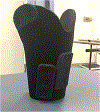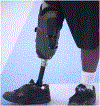A Prospective Assessment of an Adjustable, Immediate Fit, Transtibial Prosthesis
- PMID: 30734517
- PMCID: PMC9285654
- DOI: 10.1002/pmrj.12133
A Prospective Assessment of an Adjustable, Immediate Fit, Transtibial Prosthesis
Abstract
Background: There exists a need for an adjustable socket to accommodate residual limb volume and shape changes. Further, limb loss rates globally are rising and there is a large unmet need for affordable and accessible prosthetic systems.
Objective: To assess the utility of an immediate fit modular prosthetic system (iFIT Prosthetics, LLC).
Design: Prospective feasibility study involving a 2-week single-group pre-post intervention study.
Setting: Physical Medicine and Rehabilitation gait laboratory.
Participants: Participants were at least 6 months post amputation and walking with a conventional prosthesis. They were free of skin wounds, other neurological disorders, and severe pain conditions.
Methods: Participants were fit with an immediate fit prosthesis and instructed to wear it for a 2-week evaluation period. They were given a progressive wearing schedule and they completed outcome measurements at the 2-week follow-up.
Main outcome measurements: Self-reported satisfaction, gait biomechanics, and intrasocket peak pressures.
Results: Twenty-six participants entered the study, with 22 completing the single group pre-post study. They averaged 50 years (SD ±10.2) of age; four were female. Sixteen were dysvascular and 10 were traumatic in etiology. Significant differences (P = .03) in self-reported satisfaction were found in favor of the iFIT device 29.33 (SD ± 4.51) versus the conventional device 25.52 (SD ± 6.8). No falls or limb ischemia were reported. Gait biomechanics revealed no differences across any temporal characteristics. Intrasocket peak pressures were significantly lower for the iFIT prostheses overall (P = .0014), at the anterior tibia (P = .0002), and the lateral side of the residual limb (P = .013).
Conclusions: The iFIT transtibial prosthetic system appears to be safe in this short-term single-group pre-post study. This study provided preliminary evidence to support the feasibility of the iFIT system. It compared favorably to participants' conventional prostheses across all outcome measures. With its cost, adjustability, and accessibility advantages, this device may prove useful for persons with transtibial amputations. A larger multicenter study is needed to confirm these results.
Level of evidence: III.
© 2019 American Academy of Physical Medicine and Rehabilitation.
Conflict of interest statement
Figures





Similar articles
-
Improved Self-Reported Comfort, Stability, and Limb Temperature Regulation with an Immediate Fit, Adjustable Transtibial Prosthesis.Arch Rehabil Res Clin Transl. 2020 Dec;2(4):100090. doi: 10.1016/j.arrct.2020.100090. Epub 2020 Nov 2. Arch Rehabil Res Clin Transl. 2020. PMID: 33381750 Free PMC article.
-
Task-specific fall prevention training is effective for warfighters with transtibial amputations.Clin Orthop Relat Res. 2014 Oct;472(10):3076-84. doi: 10.1007/s11999-014-3664-0. Clin Orthop Relat Res. 2014. PMID: 24811543 Free PMC article. Clinical Trial.
-
The benefits of using a vacuum-assisted socket system to improve balance and gait in elderly transtibial amputees.Prosthet Orthot Int. 2016 Feb;40(1):83-8. doi: 10.1177/0309364614546927. Epub 2014 Sep 26. Prosthet Orthot Int. 2016. PMID: 25261489
-
Surgical technique of a transcutaneous osseointegration prosthesis system (TOPS) for transtibial amputees.Oper Orthop Traumatol. 2025 Apr;37(2):89-100. doi: 10.1007/s00064-025-00888-8. Epub 2025 Feb 19. Oper Orthop Traumatol. 2025. PMID: 39969578 Free PMC article. Review.
-
Principles and biomechanical response of normal gait cycle to measure gait parameters for the alignment of prosthetics limb: A technical report.Prosthet Orthot Int. 2024 Dec 18;49(4):451-466. doi: 10.1097/PXR.0000000000000391. Prosthet Orthot Int. 2024. PMID: 39692733
Cited by
-
An Immediate Fit, Adjustable, Modular Prosthetic System for Addressing World-Wide Limb Loss Disability.Arch Rehabil Res Clin Transl. 2021 Mar 15;3(2):100120. doi: 10.1016/j.arrct.2021.100120. eCollection 2021 Jun. Arch Rehabil Res Clin Transl. 2021. PMID: 34179756 Free PMC article.
-
A Scoping Review of Pressure Measurements in Prosthetic Sockets of Transfemoral Amputees during Ambulation: Key Considerations for Sensor Design.Sensors (Basel). 2021 Jul 23;21(15):5016. doi: 10.3390/s21155016. Sensors (Basel). 2021. PMID: 34372253 Free PMC article.
-
Numerical Analysis of a Transtibial Prosthesis Socket Using 3D-Printed Bio-Based PLA.Materials (Basel). 2023 Feb 28;16(5):1985. doi: 10.3390/ma16051985. Materials (Basel). 2023. PMID: 36903100 Free PMC article.
-
Improved Self-Reported Comfort, Stability, and Limb Temperature Regulation with an Immediate Fit, Adjustable Transtibial Prosthesis.Arch Rehabil Res Clin Transl. 2020 Dec;2(4):100090. doi: 10.1016/j.arrct.2020.100090. Epub 2020 Nov 2. Arch Rehabil Res Clin Transl. 2020. PMID: 33381750 Free PMC article.
-
Prospective Intervention Study Using Immediate-Fit, Adjustable Prostheses for Persons With Lower Limb Loss in Botswana-A Feasibility and Patient Acceptance Trial.Am J Phys Med Rehabil. 2024 Jan 1;104(1):38-44. doi: 10.1097/PHM.0000000000002536. Am J Phys Med Rehabil. 2024. PMID: 39668437 Free PMC article.
References
-
- Ziegler-Graham K, MacKenzie EJ, Ephraim PL et al. Estimating the prevalence of limb loss in the United States: 2005 to 2050. Arch Phys Med Rehabil. 2008; 89(3): 422–9. - PubMed
-
- Dillingham TR, Pezzin LE, MacKenzie EJ. Limb Amputation and Limb Deficiency: Epidemiology and Recent Trends in the United States. Southern Medical Journal. 2002; 95(8): 875–83. - PubMed
-
- Rutherford KR, Public-Private Partnerships are Essential in Helping Landmine Survivors, U.S. Foreign Policy Agenda, January 2004.
-
- World Health Organization “Guidelines for Training Personnel in Developing Countries for Prosthetics and Orthotics Service”2005
-
- Bowker JH, Michael JW. (ed), Atlas of Limb Prosthetics: Surgical, Prosthetic & Rehabilitation Principles, 1992 Washington, D.C. (1998).
Publication types
MeSH terms
Grants and funding
LinkOut - more resources
Full Text Sources
Other Literature Sources
Medical
Research Materials

